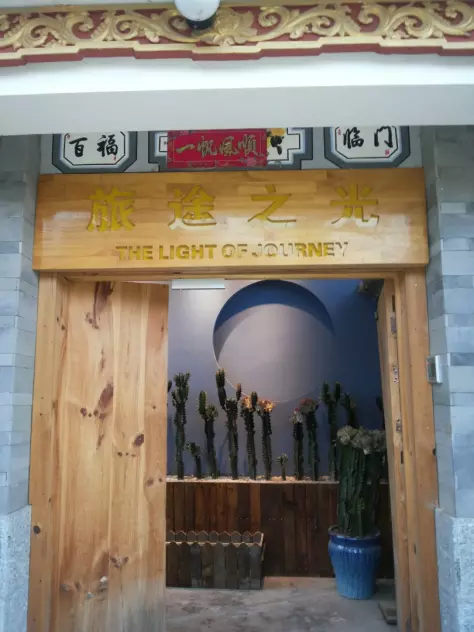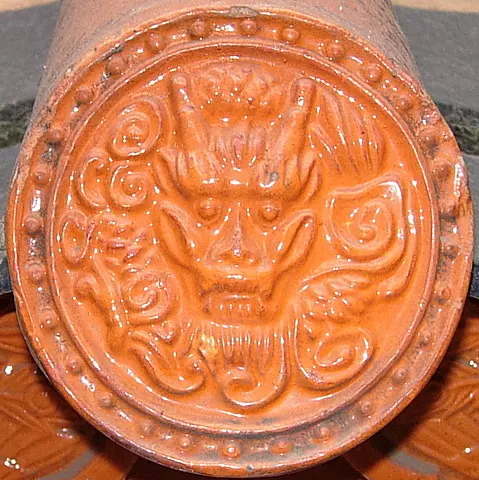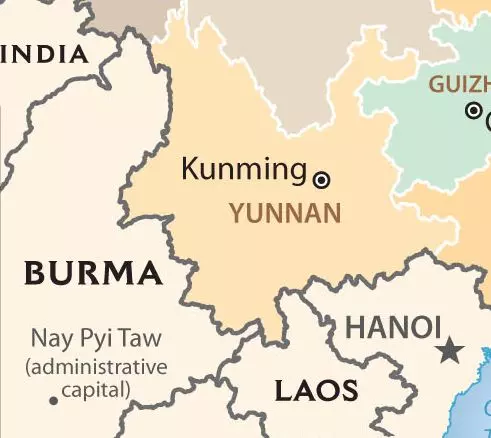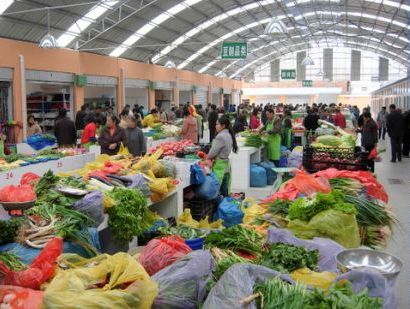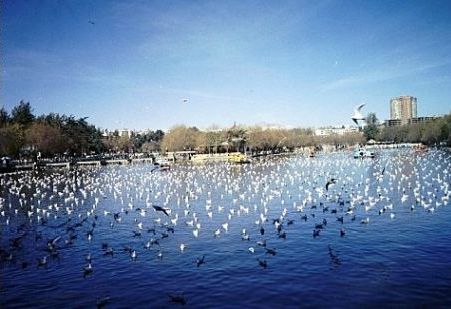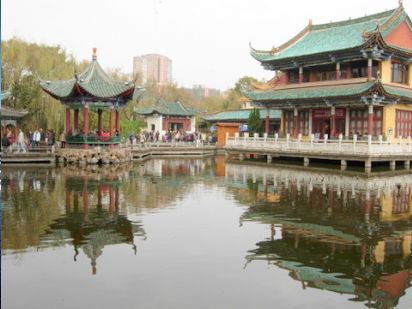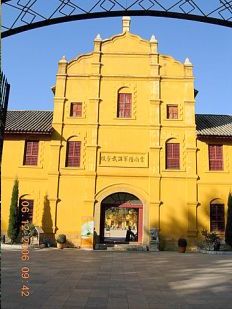Green Lake: Reflections from the Surface of China
6/ Great Wall
![]() vory Soap has many achievements, of which one is known to almost no one. Far better known, at least among Mad Men, is selling God’s free air to a gullible public. “It floats!” was a slogan of genius because it made the vice of pumping up output by filling the bar largely with air into a positive virtue. "99 and 44/100ths pure" wasn’t bad either. What could be purer, at least in the old days, than air?
vory Soap has many achievements, of which one is known to almost no one. Far better known, at least among Mad Men, is selling God’s free air to a gullible public. “It floats!” was a slogan of genius because it made the vice of pumping up output by filling the bar largely with air into a positive virtue. "99 and 44/100ths pure" wasn’t bad either. What could be purer, at least in the old days, than air?
But that white bar is also responsible for two of the great 20th Century books about China, and in part responsible for a third.
Graham Peck was first and foremost an artist, a painter, but he was also the son of a New England manufacturing father whom he addressed as “Sir” and for whom he stood up whenever the man entered the room -- all very Victorian, but this was across the pond, and it was in the 1930’s. The family factory made hairpins up the Connecticut River in Derby. As so often in capitalist history, a new technology nearly did not only the family factory but the whole industry in. In this case the new technology was the invention of the bobby pin. But somehow Peck pere was able to survive this onslaught, and even to send his son to Yale.
* * *
Through China's Wall begins not with Peck's debarkation and enchantment with Old Cathay, but with his leaving it in 1939:
I left Peking for the last time on a warm afternoon in mid-October, boarding the train from a station platform which lay freakishly quiet and deserted in the clear autumn sunlight. Two months before, every train to the coast had been frantically jammed with refugees, but that stopped after the fighting began at Shanghai and this train carried practically no Chinese; the cars were empty except for a sprinkling of Japanese officers and traveling salesmen, a guard of live Japanese soldiers, and in the baggage car, a consignment of dead ones reduced to ashes and packed away in small white-enameled boxes.
Not until page 5 do we turn back to the arrival in January 1936, after a "blank month on the Pacific," an arrival which involves his steamer "tangled in an ice-floe, then grounded on a sand-bar." Undeterred by this, his first trip the next morning out of his Legation Quarter hotel and into the Chinese city produces this:
The wide avenue beyond the walls stretched straight into the distance between lines of irregular Asiatic buildings, bald and pallid under the icy peacock sky. Before the shops, swarms of brown-faced people were moving, some dressed in black, but most in vivid blue. Down the center of the thoroughfare came a small scarlet-lacquer coach, drawn by hairy Mongol ponies and driven by a swarthy groom in a giant fur hat; past it plunged a ramshackle automobile, honking vociferously, its tonneau jammed full of fat men in uniform. Along the gutter stood a line of tufted camels and around their legs charged dozens of huge black swine, grunting ferociously at the cracking of their herders' long whip. Through the tangle a fleet of rickshaws skimmed, like peripatetic telephone booths with their tall winter hoods of quilted back felt. Behind them came three open ones, and in these sat three young girls who, to protect themselves from the dust as they rode, had thrown chiffon veils over their heads and turned their faces into floating masks, as the wind sculptured the cloth over their small features and billowed it gracefully in the air behind them..
Soon he befriends two Americans who get him to join them in a house that is in fact a part of the former palace of one of the Emperor's cousins. Life there proves so comfortable that he remains in Peking until June.
* * *
Both of Peck’s books are painter’s books. China is literally painted onto the page with all the care and keenness of observation that great portraiture demands. At a time when the visual arts were trying to get beyond realism, and indeed had already put considerable distance between themselves and the painters of the past, Peck painted (and drew -- illustrating his own books) exactly what he saw, and with a realism that is stunning. He saw a very great deal; he painted both with the traditional tools and with words. That is one thing that makes him so marvelous. No less great a travel writer, Norman Lewis, is equally observant and equally profound, but when one compares the two side-by-side and, setting aside the fact that Lewis wrote of Italy and Vietnam rather than China, it is clear which one is the painter.
Peck's first three portraits are of the aforementioned Legation Quarter, of the landscape of his journey northwest to Mongolia, and of the Gobi.
The Quarter stands in startling contrast to the city's medieval alleys and the "attractive gray uniformity of Chinese architecture," containing as it does:
plain-faced American houses, neat fat German ones, fancy French ones, and fantastically Gothic Russian ones of brick and cast-iron; random recollections of Odessa, Dijon, Dresden, or Buffalo. To an American, the American houses naturally provided the greatest shock, being islands of the completely familiar in a sea of strangeness. . . . whole rows of exact American frame houses, complete with window-boxes and near-colonial doorways.
But it is not only this surface contrast that interests him. More surprising is how all these frame houses are the setting for a "truly remarkable flowering of eccentricity." Gone is the American "social herding which segregates into separate groups those of the same ages, interests and bank accounts." In its place is a rare collection not only of diplomats, journalists, etc., but "fragments of defunct European and Asiatic aristocracies, travelling celebrities and celebrated travelers, semi-missionaries and ex-missionaries, curio-dealers, adventurers, and so on." The result is gossip, flourishing "like some musky jungle flower." Peck provides a number of examples, including this most outrageous one:
After the time he had in New Guinea, you'd think he'd be numb, but every time a waiter came through the kitchen door a fat puff of black smoke came, too, and finally he said, 'Do you mind if we change our table? I simply can't stand the smell of burning meat ever since my wife was eaten..
Not something you were likely to hear, even on a good day, at the City Lights bookstore or at McSorley's.
The one people immune to all this were, Peck thought, the Japanese, who had as early as 1931 seized and colonized the north of China. (Actually, the story is more complicated than that, though Japan did seize Manchuria in 1931. But also, Japan had defeated China in an 1894-5 war and gained Formosa, now Taiwan, as a result. Japan after this gained footholds in other parts of China because, among the many titanic mistakes made by the negotiators of the Treaty of Versailles was to give Germany's interests in China not to the Chinese but to Japan, a reward for having joined the Allies. These interests included the mainland city of Tsingtao, to which the Germans had brought beer-making techniques. Included also in the transfer were several islands in the Pacific which later proved of use to Japan in December 1941.)
Jehol (then a province in the northeast) was captured in 1933 and a "demilitarized" zone had then been established to the south of Japanese conquests, a zone that extended to the walls surrounding Peking. The eastern part of the city at Hatamen Gate was filling with Japanese civilians "most of them engaged in the campaign of wholesale smuggling which was then flooding North China with untaxed Japanese goods." A portrait within the portrait: "There were ronins -- professional rowdies of semi-military status in riding-breeches and turtle-neck sweaters; also little business men and commercial travelers in 'klassy-kut,' Western-style suits, even tourists with lunch-baskets and miniature cameras." These people were humorless in Peck's view. The result was "incidents," the expected result of friction "between a humorous race and one with no sense of the ridiculous." One of the things Peck likes best about the Chinese is their humor, to which he attributes their ability to endure. He predicts that this will wear even the Japanese down in the long run, as it did Mongol and Manchu before them. He wonders how long it will be before a Japanese commander of Peking will startle the Tokyo War Office by beginning his report:
The lotus are in bloom and yesterday for the first time a butterfly with blue wings flew into my pavilion. . .
The opportunity for the second portrait occurs because a camera-reel newsman of his acquaintance is off to make a film about Mongolia and Peck travels with him. The journey takes him literally through China's Wall and to borderland at the edge of the desert. The land had originally been grassland grazed by Mongol stock but had long been converted to farmland by the Han. On the streets of Kweihwa, however, Mongols were still to be seen: "Hulking creatures with dark, wind-creased faces, dressed in soiled, multi-colored robes, they stood out with vividly exotic effect against the background of the neat blue-clad Chinese multitudes." Among these were "silly, degenerate" princelings, deprived of real power but still influential with their own people and so feted by the Japanese and the Chinese with occasions and gifts, including girls and opium.
Fallen figures always provide color -- witness Prince Yakimov in Olivia Manning's classic The Balkan Trilogy -- and just so on the plains outside the Great Wall. One that Peck singles out is nearly blind from syphilis but continues to drive at high speed, with predictable results. To this mix is added the Chinese general and governor Fu Tso Yi. Unusually competent, he has outfoxed the local bandits by hiring them for his bandit-suppression force, then by packing them into cattle cars, locking the doors and assigning each car to a separate station, where his soldiers have been ordered to kill everyone in the car when it arrives.
The cameraman hires a Swede, a missionary son, to drive them out onto the desert, but before the man can go, he has to pick up four merino sheep for a client. Cameraman and painter go with him; the journey is eye-opening. "Whenever we stopped in either village or town, the car was surrounded by a wall of curious faces and in many of the gaping visages it was easy to imagine a trace of Turkish, Hindu, Persian, or even Caucasian blood." This curiosity extends to the Belgian mission and its two old fathers, who lavish hospitality and home-made brandy on them for nearly a day. On the road again, in their "rugged old open Dodge," they pick up the sheep and pack them into the back seat. They decide to try for a better road on the return journey. But soon they learn that a bridge they'd been counting on was down and so head off cross-country. They ask directions from a remarkable assortment, including a "mendicant Taoist magician with his long hair piled in a knot on his scalp and his greasy leather apron painted with mystic symbols." The sheep are getting restless. If the entourage’s gas-wagon was a curiosity before, now it is enough to bring a whole village out into the streets and onto the rooftops. An "immense blue cloud" would gather, "with the more-timid individuals holding their noses to prevent demons from springing out of the foreign contraption and slipping up their nostrils." They eventually drive across the river where the bridge was. But their headlights provoke fear -- and shut gates to the village. They hire a farmer who has actually been to Kweihwa to show them the way, but even he gets lost and runs off at three in the morning. Finally, the road and then two hours later, Kweihwa.
That is only the prelude. Three days later they set out in the Swede-driven Dodge, now also accompanied by a tiny Citroën of five horsepower, for the Mongol plain. Their many vehicle problems engage the locals immensely. They stay one rainy night at an inn, "a small one-roomed building set in the center of a stable-yard several inches deep in wet dung."
Its dark, smoky interior was nearly filled by two large k'angs -- brick beds -- and between them ran a narrow space which nominally served as the kitchen since it contained the stove and the water supply, but in addition housed several bedraggled chickens and a small pig, and served as a combination garbage pail and spittoon for the guests. It also made a popular toilet for the smaller children. These quarters we shared with twenty or thirty assorted Chinese, some travelers, some local farmers detained by the rain.
There is also an opium lamp in one corner, with a half-dozen smokers, including one woman sucking at the pipe while her infant sucks at her breast and another who is plucking lice from her child's head. Peck observes all this in the morning, having arrived at night and immediately gone to sleep.
This is his first real contact with ordinary Chinese,
my first opportunity to know them as a people who . . . coughed, scratched, gargled, wept, giggled, shook their fingers in reproof and their fists in anger, got drunk, were ticklish, sweated, shivered, and sneezed in entirely familiar ways.
He had put aside his drawing for six months, but now takes it up again, starting with two little girls (page 55). Back on the road, the hills dwindle gradually to hillocks "like the backs of whales." The slopes are covered with grass, "as bright in the rain as the cover of a billiard table. The earth was red and the road made a bloody gash across the green." Soon they are in Mongolia, at night, stuck in a swamp.
The third portrait which Peck paints now is of the Gobi. This is really a diptych within the triptych, landscape on the left and a Mongol encampment on the right. The arrival in (Inner) Mongolia was certainly inglorious, but they are soon extricated when dawn rises, and the three yurts nearby disgorge their Mongols. On their way west again, the land is surprisingly grass covered. This will not do for the cameraman who wants the Gobi to be covered by sand dunes, Sahara-like. Supposedly there is sand three hundred miles to the west, near the lamasery of Shandanmiao. There is a decent road there, following the way of the Silk, but it proceeds from Pailingmaio, where Japanese troops, part of the chess game with Russia, are quartered. Best to avoid that and instead go cross-country over "grassy and gravelly plains -- no sign of a road and no need of one." Completing the detour around Pailingmaio, they rejoin the caravan road and drive straight west for nearly two weeks. Time and distance erode memory. The days "have slid into one day," a day in which they stop the cars to creep up on a thousand antelope when suddenly they hear a great dark meteor falling from the sky, a meteor which suddenly sprouts winds and turns into a lammergeyer swooping on prey. Eventually the lamasery, a collection of "bald-faced temples and dormitories" looking like it is on Mars -- "with a dash of the Bronx," such as the striped awnings shading some of the windows. The sand, however, lies even further on, where only horses, donkeys and camels can go. Peck learns great disrespect for the camel on this journey, though his simple line-drawing of the head of one is both humorous and wonderful. The oasis at which they arrive provides enough sand for photos and is made more dramatic by the simultaneous arrival of a caravan and a sandstorm, all perfect for the cameraman’s preconceived image.
The unobstructed vistas encourage expansive observations. The Desert is "as different from habitable country as is the Ocean" and in both men can only pass over "by special adjustments and their only traces . . . would be relics of their failure to do so" -- "sea fish swim through the barnacled ribs of sunken ships" and "desert beetles crawl over the dried frame of an abandoned cart, or through the bones of a dead beast of burden."
Poetically the desert and sea are alike, with the same silence, the same loneliness, the same hostile immensity. And like the sea, the desert has become a scene for legendary heroics, a background against which even misfortune seems exciting. It has its peculiar hardships -- its cruelly sharp mirages, its soft smothering storms.
Then there are the people encountered. While the cars are being repaired at one point they spend much time with the mai-mais. These are Chinese who set up desert 7-11s and trade with the Mongols. From one of them Peck purchases some rock sugar which the old man wraps in paper with great formality. The scissors, the man's spectacles, the wrapping paper he realizes "had all been invented in the remote past on the Oriental side of the world."
I had always thought of Europe and America as being, so to speak, the only properly furnished rooms in a house whose other sections were either ruined or unfinished. Now it was graphically demonstrated that in a different wing, at the end of a maze of dark halls, there had always been another brightly lit room with furnishings as comfortable as ours. It was hard to have to admit that these furnishings were perhaps in a more consistent taste and had certainly been kept in good condition for a much longer time.
Which leads on to the thought that the East is not so mysterious, or sinister, as it has been made to appear on the other side of the world. If there is any mystery it is the mystery of the lack of any mystery. Indeed, the West has had to invent all that, "a fantasy in the pure Gothic style."
Certainly most of Europe has the climate of a miasmic swamp in comparison with the dry sparkling airs of China. And in the same way it does seem that many of the ideas of the West have grown up away from the sun of logic. They are full of obscurities -- the ideas of swamp-dwellers -- and are characterized by a quality of struggle, with its result which is the glorification of victory, and the result of the victorious state of mind which is the tendency to commend excesses as virtues. In contact with the smallest details of environment, the Western aim has been to exceed, not to adapt its obstacles, but to push through them and beyond them, transcend them and in the end demolish them.
“Dry sparkling airs of China” is of course a phrase which reminds us of how long ago it was that Peck was writing.
End of first half of this chapter. Second half forthcoming. See Additional postings
Chapters are sometimes supplemented by notes. Click Random Footnotes to see.
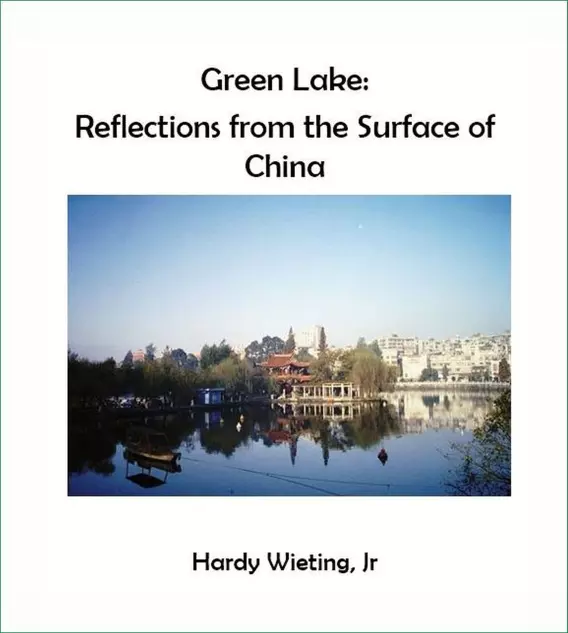
Table of Contents
Home page

Welcome to a journey, riding webbook or ebook. We alternate between roughly chronological "feet on soil" chapters and "nose in books" chapters. The introductory web posting
of the first two chapters is in full. Click Additional for other postings. The complete ebook, sans ads of course, is available now for purchase:
Click here

